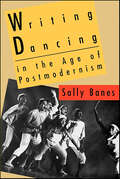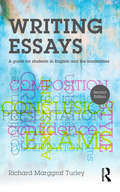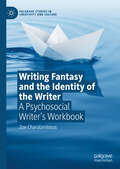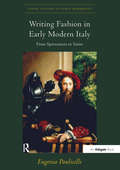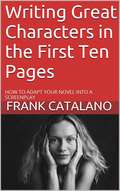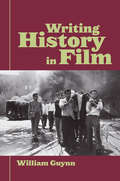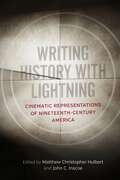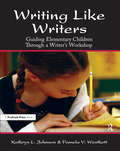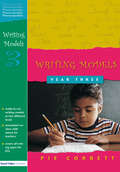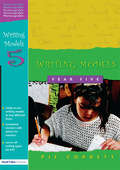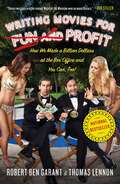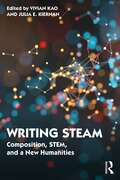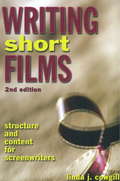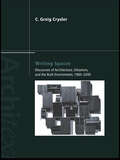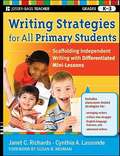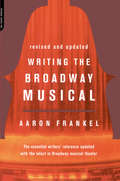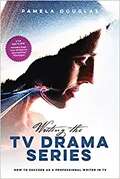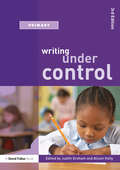- Table View
- List View
Writing Compelling Dialogue for Film and TV: The Art & Craft of Raising Your Voice on Screen
by Loren-Paul CaplinWriting Compelling Dialogue for Film and TV is a practical guide that provides you, the screenwriter, with a clear set of exercises, tools, and methods to raise your ability to hear and discern conversation at a more complex level, in turn allowing you to create better, more nuanced, complex and compelling dialogue. The process of understanding dialogue writing begins with increasing writers’ awareness of what they hear. This book provides writers with an assortment of dialogue and language tools, techniques, and exercises and teaches them how to perceive and understand the function, intent and thematic/psychological elements that dialogue can convey about character, tone, and story. Text, subtext, voice, conflict, exposition, rhythm and style are among the many aspects covered. This book reminds us of the sheer joy of great dialogue and will change and enhance the way writers hear, listen to, and write dialogue, and along the way aid the writers’ confidence in their own voice allowing them to become more proficient writers of dialogue. Written by veteran screenwriter, playwright, and screenwriting professor Loren-Paul Caplin, Writing Compelling Dialogue is an invaluable writing tool for any aspiring screenwriter who wants to improve their ability to write dialogue for film and television, as well as students, professionals, and educators.
Writing Dancing in the Age of Postmodernism
by Sally BanesDrawing of the postmodern perspective and concerns that informed her groundbreaking Terpsichore in Sneakers, Sally Banes's Writing Dancing documents the background and developments of avant-garde and popular dance, analyzing individual artists, performances, and entire dance movements. With a sure grasp of shifting cultural dynamics, Banes shows how postmodern dance is integrally connected to other oppositional, often marginalized strands of dance culture, and considers how certain kinds of dance move from the margins to the mainstream.Banes begins by considering the act of dance criticism itself, exploring its modes, methods, and underlying assumptions, and examining the work of other critics. She traces the development of contemporary dance from the early work of such influential figures as Merce Cunningham and George Balanchine to such contemporary choreographers as Molissa Fenley, Karole Armitage, and Michael Clark. She analyzes the contributions of the Judson Dance Theatre and the Workers' Dance League, the emergence of Latin postmodern dance in New York, and the impact of black jazz in Russia. In addition, Banes explores such untraditional performance modes as breakdancing and the "drunk dancing" of Fred Astaire.
Writing Essays: A guide for students in English and the humanities
by Richard Marggraf TurleyEssays are a major form of assessment in higher education today and this is a fact that causes some writers a great deal of anxiety. Fortunately, essay writing is a skill that can be learned, like any other. Through precise explanations, this fully updated edition of Writing Essays gives you the confidence to express yourself coherently and effectively. It demystifies the entire process of essay writing, helping you to become proficient and confident in every aspect. Writing Essays reveals the tricks of the trade, making your student life easier. You’ll learn how to impress tutors by discovering exactly what markers look for when they read your work. Using practical examples selected from real student assignments and tutor feedback, this book covers every aspect of composition, from introductions and conclusions, down to presentation and submission. It also advises you on stress-free methods of revision, helps with exam essays, explains the principles of effective secondary source management, and shows you how to engage meaningfully with other critics’ views. A new chapter will also guide you through the intricacies of the undergraduate dissertation. As a full-time university professor, Richard Marggraf Turley counsels students and assesses their work every day, helping him to recognise the challenges that they face. Accessible, concise and full of practical examples, Writing Essays is a response to these challenges and will be an invaluable companion for Humanities students who wish to improve their grades and become confident in the art of essay writing.
Writing Fantasy and the Identity of the Writer: A Psychosocial Writer’s Workbook (Palgrave Studies in Creativity and Culture)
by Zoe CharalambousThis book presents the innovative pedagogy of Writing Fantasy: a method for exploring and shifting one’s identity as a writer. The book draws on qualitative research with undergraduate creative writing students and fills a gap in the literature exploring creative writing pedagogy and creative writing exercises. Based on the potential to shift writer identity through creative writing exercises and the common ground that these share with the stance of the Lacanian analyst, the author provides a set of guidelines, exercises and case studies to trace writing fantasy, evidenced in one’s creative writing texts and responses about creative writing. This innovative work offers fresh insights for scholars of creativity, Lacan and psychosocial studies, and a valuable new resource for students and teachers of creative writing.
Writing Fashion in Early Modern Italy: From Sprezzatura to Satire (Visual Culture in Early Modernity)
by Eugenia PaulicelliThe first comprehensive study on the role of Italian fashion and Italian literature, this book analyzes clothing and fashion as described and represented in literary texts and costume books in the Italy of the 16th and 17th centuries. Writing Fashion in Early Modern Italy emphasizes the centrality of Italian literature and culture for understanding modern theories of fashion and gauging its impact in the shaping of codes of civility and taste in Europe and the West. Using literature to uncover what has been called the ’animatedness of clothing,’ author Eugenia Paulicelli explores the political meanings that clothing produces in public space. At the core of the book is the idea that the texts examined here act as maps that, first, pinpoint the establishment of fashion as a social institution of modernity; and, second, gauge the meaning of clothing at a personal and a political level. As well as Castiglione’s The Book of the Courtier and Cesare Vecellio’s The Clothing of the Renaissance World, the author looks at works by Italian writers whose books are not yet available in English translation, such as those by Giacomo Franco, Arcangela Tarabotti, and Agostino Lampugnani. Paying particular attention to literature and the relevance of clothing in the shaping of codes of civility and style, this volume complements the existing and important works on Italian fashion and material culture in the Renaissance. It makes the case for the centrality of Italian literature and the interconnectedness of texts from a variety of genres for an understanding of the history of Italian style, and serves to contextualize the debate on dress in other European literatures.
Writing Fiction
by Linda Anderson Derek NealeWriting Fiction offers the novice writer engaging and creative activities, making use of insightful, relevant readings from well-known authors to illustrate the techniques presented. This volume makes use of new versions of key chapters from the recent Routledge/Open University textbook Creative Writing: A Workbook with Readings for writers who are specializing in fiction. Using their experience and expertise as teachers as well as authors, Linda Anderson and Derek Neale guide aspiring writers through such key aspects of writing as: how to stimulate creativity keeping a writer’s notebook character creation setting point of view structure showing and telling. The volume is further updated to include never-before published interviews with successful fiction writers Andrew Cowan, Stevie Davies, Maggie Gee, Andrew Greig, and Hanif Kureishi. Concise and practical, Writing Fiction offers an inspirational guide to the methods and techniques of authorship and is a must-read for aspiring writers.
Writing Great Characters in the First Ten Pages: How to Adapt Your Novel Into a Screenplay
by Frank CatalanoWriters of fiction and non-fiction and industry professionals from the publishing business primarily attended the 25th Annual Writer's Conference. Mr. Catalano's seminars focused upon those writers seeking to adapt their novels into screenplays. The complete list of seminar presentations by Frank Catalano for this conference is: BOOK 1: WRITE GREAT CHARACTACTERS IN THE FIRST TEN PAGES BOOK 2: WRITING ON YOUR FEET - IMPROVISATIONAL TECHNIQUES FOR WRITERS BOOK 3: START YOUR STORY AT THE END: FOR WRITERS BOOK 4: THE FIRST TEN PAGES BOOK 5: BOOK TO SCREEN BOOK 6: ACTING IT OUT - IMPROVISATIOINAL TECHNIQUES FOR WRITERS II BOOK 7: WRITE GREAT DIALOGUE
Writing History in Film
by William GuynnHistorical film has been an important genre since the earliest silent films. The French Revolution, the American Civil War, the conquest of the New World, World War II--all have been repeatedly represented in film. But how do we distinguish between fictionalized spectacle and authentic historical representation? Writing History in Film sets out the narratological, semiological, rhetorical, and philosophical bases for understanding how film can function as a form of historical interpretation and representation. With case studies and an interdisciplinary approach, William Guynn examines the key issues facing film students and scholars, historians, and anyone interested in how we see our historical past.
Writing History with Lightning: Cinematic Representations of Nineteenth-Century America
by Catherine Clinton William L. Andrews Lesley J. Gordon John C. Inscoe Marcus Rediker John F. Marszalek John David Smith Graham Hodges Matthew Stanley Diane Miller Sommerville Michael Burlingame Joseph Beilein Matthew C. Hulbert Brian Rouleau Tom Lee Kenneth Greenberg Jonathon Sarris Ryan Keating Donna Barbie Allison Dorsey Stephen Whitfield Nicole Etcheson Drew Swanson James Crisp Kevin Waite Jacob LeeFilms possess virtually unlimited power for crafting broad interpretations of American history. Nineteenth-century America has proven especially conducive to Hollywood imaginations, producing indelible images like the plight of Davy Crockett and the defenders of the Alamo, Pickett’s doomed charge at Gettysburg, the proliferation and destruction of plantation slavery in the American South, Custer’s fateful decision to divide his forces at Little Big Horn, and the onset of immigration and industrialization that saw Old World lifestyles and customs dissolve amid rapidly changing environments. Balancing historical nuance with passion for cinematic narratives, Writing History with Lightning confronts how movies about nineteenth-century America influence the ways in which mass audiences remember, understand, and envision the nation’s past. In these twenty-six essays—divided by the editors into sections on topics like frontiers, slavery, the Civil War, the Lost Cause, and the West—notable historians engage with films and the historical events they ostensibly depict. Instead of just separating fact from fiction, the essays contemplate the extent to which movies generate and promulgate collective memories of American history. Along with new takes on familiar classics like Young Mr. Lincoln and They Died with Their Boots On, the volume covers several films released in recent years, including The Revenant, 12 Years a Slave, The Birth of a Nation, Free State of Jones, and The Hateful Eight. The authors address Hollywood epics like The Alamo and Amistad, arguing that these movies flatten the historical record to promote nationalist visions. The contributors also examine overlooked films like Hester Street and Daughters of the Dust, considering their portraits of marginalized communities as transformative perspectives on American culture. By surveying films about nineteenth-century America, Writing History with Lightning analyzes how movies create popular understandings of American history and why those interpretations change over time.
Writing Like Writers: Guiding Elementary Children Through a Writer's Workshop
by Kathryn L. Johnson Pamela V. WestkottBuild a classroom of excited, talented young writers. This wonderful teaching resource offers a complete approach to creating a classroom of enthusiastic, skillful student writers.The authors provide a comprehensive approach to teaching writing in the classroom. This book offers the strategies teachers need to teach writing skills that meet national standards and to produce excellent results from children.Topics addressed in this guidebook include:creating the writing classroom,teaching the writing process,teaching effective writing strategies,teaching elements of story structure,teaching the advanced craft of writing, andusing a writer's workshop to teach good writing. Writing is a great differentiator. During the writer's workshop, each student is engaged in meaningful ways. Pulling together more than three decades of practical experience and research on the best strategies for teaching writing, Writing Like Writers offers a friendly, easy-to-use guide for any teacher seeking to build a classroom of successful writers.Grades 2-6
Writing Models Year 3 (Writing Models Ser.)
by Pie CorbettTeachers who want to cut lesson planning time should welcome this series, revised in line with the new literacy framework in the second edition. Writing Models aims to help teachers cover every sort of writing type they need; fine tune lessons by following key teaching points for each model; and deliver the new literacy units to pupils of varying a
Writing Models Year 5 (Writing Models Ser.)
by Pie CorbettTeachers who want to cut planning time and save energy should welcome this series. It will help teachers to: cover every sort of writing type they need to at Key Stage with a model provided for each one; fine tune lessons by following key teaching points for each model; deliver the literacy hour to pupils of every ability using different versions of the same model.
Writing Movies for Fun and Profit: How We Made a Billion Dollars at the Box Office and You Can, Too!
by Thomas Lennon Robert Ben GarantThis is the only screenwriting guide by two guys who have actually done it (instead of some schmuck who just gives lectures about screenwriting at the airport Marriott); “These guys are proof that with no training and little education, ANYONE can make it as a screenwriter” (Paul Rudd).Robert Ben Garant and Thomas Lennon’s movies have made over a billion dollars at the box office—and now they show you how to do it yourself! This book is full of secret insider information about how to conquer the Hollywood studio system: how to write, pitch, structure, and get drunk with the best of them. Well…maybe not the best of them, but certainly the most successful. (If you’re aiming to win an Oscar, this is not the book for you!) But if you can type a little, and can read and speak English—then you too can start turning your words into stacks of money! This is the only screenwriting book you will ever need (because all other ones pretty much suck). In these pages, Garant and Lennon provide the kind of priceless tips you won’t find anywhere else, including: -The art of pitching -Getting your foot in the door -Taking notes from movie stars -How to get fired and rehired -How to get credit and royalties! And most important: what to buy with the huge piles of money you’re going to make! Writing Movies for Fun and Profit will take you through the highs and lows of life as a professional screenwriter. From the highs of hugging Gisele Bündchen and getting kung fu punched by Jackie Chan to the soul-crushing lows of Herbie: Fully Loaded. Read this book and you’ll have everything you need to make your first billion the old-fashioned way—by “selling out” in show business! A portion of the authors’ proceeds from this book are being contributed to the USO of Metropolitan Washington, a private, nonprofit organization dedicated to serving active duty military members and their families in the greater Washington, DC, region.
Writing STEAM: Composition, STEM, and a New Humanities
by Vivian KaoThis edited collection positions writing at the center of interdisciplinary higher education, and explores how writing instruction, writing scholarship, and writing program administration bring STEM and the humanities together in meaningful, creative, and beneficial ways. Writing professionals are at the forefront of a cross-pollination between STEM (Science, Technology, Engineering, and Mathematics) and the arts and humanities. In their work as educators, scholars, and administrators, they collaborate with colleagues in engineering, scientific, technical, and health disciplines, offer new degree programs that allow students to bring the humanities to bear on design experiments, and build an academic culture that promotes a vision of the humanities in the twenty-first century, as well as a vision of technology that is decidedly human. This collection surveys and promotes that work through chapters focused on writing instruction, writing scholarship, and writing program administration, covering topics that include data-driven writing courses, public science communication, non-traditional college students, creative writing, gamification, skills transfer, and Writing Across the Curriculum programs. Writing STEAM will be essential reading for scholars, instructors, and administrators in writing studies, rhetoric and composition, STEM, and a variety of interdisciplinary programs; it will aid in teacher training for both humanities and STEM courses focused on writing and communication.
Writing STEAM: Composition, STEM, and a New Humanities
by Vivian KaoThis edited collection positions writing at the center of interdisciplinary higher education, and explores how writing instruction, writing scholarship, and writing program administration bring STEM and the humanities together in meaningful, creative, and beneficial ways.Writing professionals are at the forefront of a cross-pollination between STEM (Science, Technology, Engineering, and Mathematics) and the arts and humanities. In their work as educators, scholars, and administrators, they collaborate with colleagues in engineering, scientific, technical, and health disciplines, offer new degree programs that allow students to bring the humanities to bear on design experiments, and build an academic culture that promotes a vision of the humanities in the twenty-first century, as well as a vision of technology that is decidedly human. This collection surveys and promotes that work through chapters focused on writing instruction, writing scholarship, and writing program administration, covering topics that include data-driven writing courses, public science communication, non-traditional college students, creative writing, gamification, skills transfer, and Writing Across the Curriculum programs. Writing STEAM will be essential reading for scholars, instructors, and administrators in writing studies, rhetoric and composition, STEM, and a variety of interdisciplinary programs; it will aid in teacher training for both humanities and STEM courses focused on writing and communication.
Writing Screenplays That Sell: The Complete Guide to Turning Story Concepts into Movie and Television Deals
by Michael HaugeFor more than twenty years, Writing Screenplays That Sell has been hailed as the most complete guide available on the art, craft, and business of writing for movies and television. Now fully revised and updated to reflect the latest trends and scripts, Hollywood story expert and script consultant Michael Hauge walks readers through every step of writing and selling successful screenplays. If you read only one book on the screenwriter's craft, this must be the one.
Writing Short Films: Structure and Content for Screenwriters
by Linda J. CowgillThis new edition has been completely updated and revised along with the addition of several new chapters. Currently, this title remains the best selling university text book on writing short film screenplays.
Writing Spaces: Discourses of Architecture, Urbanism and the Built Environment, 1960–2000 (Architext)
by C. Greig CryslerWriting Spaces examines some of the most important discourses in spatial theory of the last four decades, and considers their impact within the built environment disciplines. The book will be a key resource for courses on critical theory in architecture, urban studies and geography, at both the graduate and advanced undergraduate level.
Writing Strategies for All Primary Students
by Cynthia A. Lassonde Janet C. RichardsA guide for teaching all your students the skills they need to be successful writersThe 25 mini-lessons provided in this book are designed to develop students' self-regulated writing behaviors and enhance their self-perceived writing abilities. These foundational writing strategies are applicable and adaptable to all primary students: emergent, advanced, English Language Learners, and struggling writers. Following the SCAMPER (Screen and assess, Confer, Assemble materials, Model, Practice, Execute, Reflect) mini-lesson model devised by the authors, the activities show teachers how to scaffold the writing strategies that students need in order to take control of their independent writing.Reveals helpful writing strategies, including making associations, planning, visualizing, accessing cues, using mnemonics, and moreOffers ideas for helping students revise, check, and monitor their writing assignmentsExplains the author's proven SCAMPER model that is appropriate for students in grades K-3Let Richards and Lassonde--two experts in the field of childhood education--guide you through these proven strategies for enhancing young children's writing skills.
Writing Television Drama: Get Your Scripts Commissioned
by Nicholas GibbsBreak Into Writing For Television takes you from the very first line of the script through to becoming a regular writer for soaps and 'continuing dramas'. It starts with the basics of different types of script and production, and moves on to getting ideas, shaping character and dialogue, re-writing, pitching work and the practicalities of who does what in the production world, in both the UK and the US. Structured around a practical, progressive, goal-orientated approach, each chapter contains a diagnostic test, case studies, practical exercises and Aide Memoire boxes. Each chapter concludes with a reminder of the key points of the chapter (Focus Points) and a round-up of what to expect in the next (Next Step), which will whet your appetite for what's coming and how it relates to what you've just read.
Writing Television Drama: Teach Yourself
by Nicholas GibbsBreak Into Writing For Television takes you from the very first line of the script through to becoming a regular writer for soaps and 'continuing dramas'. It starts with the basics of different types of script and production, and moves on to getting ideas, shaping character and dialogue, re-writing, pitching work and the practicalities of who does what in the production world, in both the UK and the US. Structured around a practical, progressive, goal-orientated approach, each chapter contains a diagnostic test, case studies, practical exercises and Aide Memoire boxes. Each chapter concludes with a reminder of the key points of the chapter (Focus Points) and a round-up of what to expect in the next (Next Step), which will whet your appetite for what's coming and how it relates to what you've just read.
Writing The Broadway Musical
by Aaron FrankelBrimming with advice and techniques, this essential reference for book- and songwriters clearly explains the fundamentals of the three crafts of a musical-book, music, and lyrics. Using copious examples from classic shows, Frankel has created the quintessential musical writers' how-to. Among the topics:definitions of musical theater; differences between musical books and straight plays and between poetry and lyrics; what a score is and how it develops; how to write for the voice; and how to audition musicals for producers. With a new introduction and revised text, Frankel's work is ready to guide a new generation of aspiring writers.
Writing The Romantic Comedy, 20th Anniversary Expanded and Updated Edition: The Art of Crafting Funny Love Stories for the Screen
by Billy Mernit“Writing the Romantic Comedy is so much fun to read it could pop a champagne cork.”—Alexa Junge, writer and producer of FriendsRevised and expanded to celebrate a new generation of romantic comedies, Billy Mernit’s insightful look into the mechanics of writing Hollywood’s most enduring genre features case studies that reveal the screenwriting secrets behind classics new and old.Whether you’re a first-time screenwriter, an intermediate marooned in the rewriting process, or a professional wanting to explore the latest genre trends, this thoroughly charming and insightful guide to the basics of crafting a winning and innovative script will take you step by step from “meet cute” all the way to “joyous defeat.” You’ll learn the screenwriting secrets behind some of the funniest scenes ever written; how to create characters and dialogue that getsparks flying; why some bedroom scenes sizzle and others fall flat; and much more. Written in a refreshingly accessible style and updated and expanded to recognize the contributions of a fresh generation of romantic comedies, this newly revised 20th Anniversary edition of Writing the Romantic Comedy features case studies drawn from beloved romantic classics such as When Harry Met Sally, Annie Hall, Tootsie, and The Lady Eve to modern-day favorites including Hitch, (500) Days of Summer, Bridesmaids, and Silver Linings Playbook. Field-tested writing exercises are also included, guaranteed to short-circuit potential mistakes and ensure inspiration.
Writing The TV Drama Series: How To Succeed As A Professional Writer In TV
by Pamela DouglasThis revised and updated edition is a complete resource for anyone who wants to write and produce for television drama series or create an original series, as well as for teachers in screenwriting classes and workshops. It leads the reader step-by-step through every stage of the development and writing process, offering practical industry information and artistic inspiration. The Fourth Edition leads readers into the future and engages provocative issues about the interface between traditional TV and emerging technologies. It’s also the single most comprehensive source on what is happening in original television drama around the world, with surveys of 15 countries.
Writing Under Control
by Alison Kelly Judith GrahamNow in its third edition and reflecting changes in the Primary National Strategy, this best-selling textbook introduces primary teachers to key issues in the teaching of writing. Strongly rooted in classroom practice, the book includes: the history, theory and practice of teaching writing children writing in and out of school EAL and gender issues in writing the development of writing across the years of the primary school planning classroom routines and organising resources balancing the composition and transcription elements in writing monitoring and assessing writing meeting individual needs managing specific learning difficulties in writing, such as dyslexia With its companion Reading under Control (also in its third edition), this book provides undergraduate and postgraduate teachers with comprehensive guidance for the teaching of literacy.

